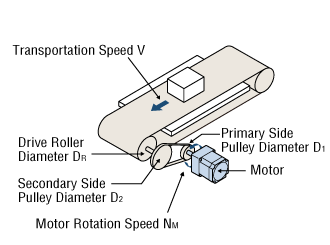How Do I Convert Units Related to the Motor Speed?


-

Mr. Vex, what are you doing staring at the calculator? Selection calculations?
-

Ah, Ms. Ori! I’m doing the motor selection to be used for a belt conveyor. I would like to convert the speed on the conveyor, 10 m/min, to the motor rotation speed so I can make a selection, but I'm not sure how to calculate...
-

We often think of transportation speed in the mechanism in terms of m/min or mm/sec, but motors are thought of in terms of rotation speed, r/min, which can be confusing. But it's not difficult if you know the key points.
-

Really? Please tell me what they are!
-

There are two key points.
The first is to match the units of time.
The second is to calculate how many rotations the travel distance on the mechanism would be on the output shaft of the motor. -

This time, the time unit is the same min, so we just need to figure out how many rotations of the motor are required for a travel distance of 10 m on the conveyor. The conveyor we have now selected has a drive roller diameter of φ0.03 m, so the circumference is about 0.094 m. To move forward 10 m, 10 m divided by 0.094 m equals about 106 revolutions, so to move at 10 m/min, we need to rotate the motor at about 106 r/min!
-

That’s right. There is a formula for converting the belt's transportation speed to the motor's rotation speed as expressed in r/min, so I will teach you the formula.
Motor rotation speed : NM [r/min]
Belt transport speed : V [m/min]
Diameter of drive roller : DR [mm]
Primary pulley diameter and number of teeth : D1 [mm] (for diameter)
Secondary pulley diameter and number of teeth : D2 [mm] (for diameter)-
\(\mathrm{[m/min]} \rightarrow \mathrm{[r/min]}\text{の場合}\)
\(\begin{align}\mathrm{N}_\mathrm{M} = 1000\cdot \frac{\mathrm{V}}{\pi \ \mathrm{D}_\mathrm{R}}\cdot \frac{\mathrm{D}_{2}}{\mathrm{D}_{1}}\end{align}\)
-

-
-

I know ball screws are often used other than conveyors, but is the concept the same for ball screws?
-

The key point is the same as before. But for ball screws, we often use mm/sec. Do you know the way to convert from mm/sec to r/min?
-

All I have to do is adjust the units to min, and work out how many revolutions of the motor would be the distance travels on the ball screw!
-

Correct! When selecting a motor, it is often necessary to convert units such as transportation speed into other units, so it is important to understand the concept. However, it's difficult to calculate by a calculator every time, so it's convenient to use the technical support tool’s speed converter. You can easily convert the transportation speed from m/min, m/sec, or mm/sec to r/min, the motor rotation speed.

-

Thank you very much. Now I’ll be able to make the selection with confidence.
-

Wait a minute! What kind of motor is the customer planning to use this time?
-

The customer was concerned about the stopping accuracy of the motor, so I have planned to select a stepper motor.
-

For stepper motor, you often set the motor's rotation speed in Hz using the pulse speed. Do you know how to convert from r/min to Hz?
-

Let me take care of it! If you know the movement angle per pulse, you can easily calculate it, right?
Pulse speed : f [Hz]
Angle of movement per pulse : θS [deg]
Motor rotation speed : NM [r/min]■Conversion formula from rotation speed NM [r/min] to pulse speed f [Hz]
\(\begin{align}\mathrm{f}= \mathrm{N}_\mathrm{M} \cdot \frac{360}{\theta_\mathrm{S}}\cdot \frac{1}{60}\end{align}\)
-

Correct! It's easy to convert from r/min of rotation speed to Hz of pulse speed using the technical support tool’s speed converter.
The technical support tool can also convert torque values into units, as well as acceleration and acceleration/deceleration rates into units, so give it a try. Also, if you don't have a specific motor in mind, you can use the motor sizing tool to easily select even the motor’s product name, so why don't you let your customers know about it? You don’t need a login so anyone can use it right away.
-

Thank you very much! I'll make the selection right away and suggest the most suitable motor for the customer!